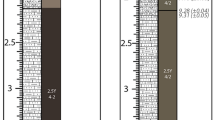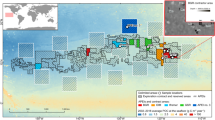Abstract
Three sites in the Red Sea were investigated to assess the variability of composition in Holocene sediments of the backreef environment within 0–2 m of water depth. This is important because composition of the sediment is commonly used to estimate water depth in ancient carbonate rocks. The site located at the King Abdullah Economic City (Saudi Arabia) contains a fringing reef with the reef tract located very close to the beach at the north end, flaring to the south to produce a narrower backreef area compared to the other two sites. This geometry produces a north to south current with a velocity of up to 15 cm s−1, particularly during high onshore winds. The sediments contain predominantly non-skeletal grains, including peloids, coated grains, ooids, and grapestones that form on the bottom. The percentage of coralgal grains in the sediment was significantly lower than at the other two sites studied. Om Al Misk Island and Shoaiba have a much lower-velocity current within the backreef zone and contain predominantly coralgal sediments from the beach to the landward edge of the reef tract. The two locations containing the predominantly coralgal microfacies were statistically similar, but the King Abdullah Economic City site was statistically different despite having a similar water depth profile. Slight differences in reef configuration, including reef orientation and distance from the shore, can produce considerable differences in sediment thickness and composition within the backreef environment, which should induce caution in the interpretation of water depth in ancient carbonate rocks using composition.








Similar content being viewed by others
References
Al-Rousan S, Rasheed M, Al-Horani F, Manasrah R (2006) Geochemical and textural properties of carbonate and terrigenous sediments along the Jordanian Coast of the Gulf of Aqaba. Journal of Oceanography 62:839–849
Al-Sayari SS, Dullo C, Hotzl H, Jado AR, Zotl JG (1984) The Quaternary along the coast of the Gulf of Aqaba. In: Jado AR, Zolt JG (eds) Quaternary period in Saudi Arabia, vol 2. Springer, New York, pp 32–47
Bahafzallah ABK, El Askary MA (1981) Sedimentological and micropaleontological investigations of the beach sands around Jeddah, Saudi Arabia. Bulletin of the Faculty of Earth Sciences, King Abdulaziz University, Jeddah 4:25–42
Behairy AKA (1980) Clay and carbonate mineralogy of the reef sediments north of Jeddah, west coast of Saudi Arabia. Bulletin of the Faculty of Earth Sciences, King Abdulaziz University, Jeddah 4:265–279
Behairy AKA, El-Sayed MKh (1983) Bathymetry and bottom relief beyond the reef complex off Jeddah, Red Sea. Journal of the Faculty of Marine Science, King Abdulaziz University, Jeddah 3:73–80
Behairy, AKA, Sheppard CRC, El-Sayed MK (1992) A review of the geology of coral reefs in the Red Sea. United Nations Environment Programme Regional Seas Reports and Studies No. 152, UNEP, Nairobi, Kenya
Bemert G, Ormond R (1981) Red Sea coral reefs. Kegan Paul International, London, p 192
Bruggemann JH, van Kessel AM, van Rooij JM, Breeman AM (1996) Bioerosion and sediment ingestion by the Caribbean parrotfish Scarus vetula and Sparisoma viride: implications of fish size, feeding mode and habitat use. Mar Ecol Prog Ser 134:59–71
Dehwah AHE, Missimer TM (2013) Technical feasibility of using gallery intakes for seawater RO facilities, northern Red Sea coast of Saudi Arabia: the King Abdullah Economic City site. Desalination and Water Treatment 51:6472–6481
Dehwah AHA, Jadoon KZ, Al-Mashharawi S, Missimer TM (2016) Effects of nearshore evaporation rates on the design of seabed gallery intake systems for SWRO facilities located along the Red Sea shoreline of Saudi Arabia. Desalination and Water Treatment 57:22726–22733
Dehwah AHA, Li S, Al-Mashharawi S, Mallon FL, Batang Z, Missimer TM (2015) Effects of intake depth on raw water quality in the Red Sea, Chapter 6. In: Missimer TM, Jones B, Maliva RG (eds) Intakes and outfalls for seawater reverse osmosis desalination facilities: Innovations and environmental impacts. Springer, Heidelberg, Germany, pp 105–124
DeVantier L, Pilcher N (2000) The status of coral reefs in Saudi Arabia. In: Wilkinson C (ed) Status of coral reefs of the world. Global Coral Reef Monitoring Network and Australian Institute of Marine Science, Townsville
Diaz MR, Swart PK, Eberli GP, Oeblert AM, Devlin Q, Saeid A, Altabet MA (2015) Geochemical evidence of microbial activity within ooids. Sedimentology 62:2090–2112
Done TJ (1982) Patterns in the distribution of coral communities across the central Great Barrier Reef. Coral Reefs 1:95–107
Doyle LJ, Roberts HH (1987) Histories of coexisting reefs and terrigenous sediments: the Gulf of Eilat (Red Sea), Java Sea, and Neogene basin of the Negev, Israel. In: Friedman GM (ed) Carbonate-clastic transitions. Developments in sedimentology. Elsevier, Amsterdam, Netherlands, pp 77–97
Dullo WV (1990) Facies, fossil record, and age of Pleistocene reefs from the Red Sea (Saudi Arabia). Facies 22:1–45
Dullo WC, Jado AR (1984) Facies, zonation pattern and diagenesis of Pleistocene reefs on eastern Red Sea coast. In: Saad MAH (ed.) Proceedings of the Symposium on the Coral Reef Environment of the Red Sea. Faculty of Marine Science, King Abdulaziz University, Jeddah, Saudi Arabia, pp. 254–275
Durgaprassada Rao NVN, Behairy AKA (1984) Mineralogical variations in the unconsolidated sediments of El-Qars reef, north of Jeddah, west coast of Saudi Arabia. Cont Shelf Res 3:489–498
Durgaprassada Rao NVN, Behairy AKA (1986) Nature and composition of shore-zone sediments between Jeddah and Yanbu, eastern Red Sea. Mar Geol 70:287–305
Edwards AJ (1987) Climate and oceanography. In: Edwards AJ, Head SM (eds) Key environments: Red Sea. Pergamon Press, Oxford, pp 45–69
Flügel E (2004) Microfacies of carbonate rocks: analysis, interpretation, and application. Springer, Berlin
Folk RL (1968) Petrology of sedimentary rocks. Hemphill’s, Austin, Texas
Folk RL, Ward WC (1957) Brazos River bar: a study in the significance of grain size parameters. J Sediment Petrol 27:2–26
Friedman GM (1968) Geology and geochemistry of reefs, carbonate sediments and water, Gulf of Aqaba, Red Sea. J Sediment Petrol 38:895–919
Gabrie C, Montaggioni LM (1982) Sedimentary facies from the modern coral reefs, Jordan Gulf of Aqaba, Red Sea. Coral Reefs 1:115–125
Gheith AM (2000) Sedimentary reflections of the coastal processes on the shore zone sediments along the eastern Red Sea Coast, Saudi Arabia. Zeitschrift Fur Geomorphologie 44:449–468
Gheith AM, Abou Ouf MA (1994) Textural characteristics, mineralogy and fauna in the shore zone sediments at Rabigh and Sharm Al-Kharrar, eastern Red Sea, Saudi Arabia. Journal of the Faculty of Marine Sciences, King Abdulaziz University, Jeddah 7:107–131
Gvirtzman G, Buchbinder B, Sneh A, Nir Y, Friedman GM (1977) Morphology of the Red Sea fringing reefs: a result of the erosional pattern of the last glacial low-stand sea level and the following Holocene recolonization. Mémoires du Bureau de Recherches Géologique et Minières 98:480–491
Handford CR, Loucks RG (1993) Carbonate depositional sequences and sequence tracts—responses of carbonate platforms to relative sea-level changes. In: Loucks RG, Sarg RJ (eds) Carbonate sequence stratigraphy: recent developments and applications. AAPG Memoir 57, American Association of Petroleum Geologists, Tulsa, OK, USA, pp 3–41
Head SM (1987) Coral and coral reefs of the Red Sea. In: Edwards AJ, Head SM (eds) Key environments: Red Sea. Pergamon Press, Oxford, pp 128–151
Krumbein WC, Monk GD (1943) Permeability as a function of the size parameters of unconsolidated sands. Transactions of the American Institute of Mining, Metallurgical and Petroleum Engineers 151:153–163
Lujan LR, Missimer TM (2014) Technical feasibility of a seabed gallery system for SWRO facilities at Shoaiba, Saudi Arabia and regions with similar geology. Desalination and Water Treatment 52:7431–7442
Manaa A (2011) Late Pleistocene raised coral reefs in the eastern Red Sea—Rabigh, Saudi Arabia. Research Thesis, School of Earth and Environmental Sciences, University of Wollongong, Wollongong, Australia
Martindale W (1992) Calcified epibionts and paleoecological tools: examples from the Recent and Pleistocene of Barbados. Coral Reefs 11:167–177
Montaggioni LF, Behairy AKA, El-Sayed MK, Yusuf N (1986) The modern reef complex, Jeddah area, Red Sea: a facies model for carbonate sedimentation on embryonic passive margins. Coral Reefs 5:127–150
Nelsen JE Jr, Ginsburg RN (1986) Calcium carbonate production by epibionts on Thalassia in Florida Bay. J Sediment Petrol 56:622–628
Perry GLW (2002) Landscape, space and equilibrium: shifting viewpoints. Prog Phys Geog 26:339–359
PERSGA/GEF (2000) The status of coral reefs in Saudi Arabia. PERSGA, Jeddah, Saudi Arabia
PERSGA/GEF (2002) The Red Sea and Gulf of Aden regional network of marine protected areas. Regional master plan. PERSGA Technical Series No. 1, PERSGA, Jeddah, Saudi Arabia, 81 p
PERSGA/GEF (2003) Coral reefs in the Red Sea and Gulf of Aden, surveys 1990 to 2000, summary and recommendations. PERSGA Technical Series No. 7, PERSGA, Jeddah, Saudi Arabia
Purkis SJ, Harris PM, Ellis J (2012) Patterns of sedimentation in the contemporary Red Sea as an analog for ancient carbonates in rift settings. Journal of Sedimentary Research 82:859–870
Purkis SJ, Rowlands GP, Kerr JM (2015) Unravelling the influence of water depth and wave energy on the facies diversity of shelf sediments. Sedimentology 62:541–565
R Core Team (2016) R: a language and environment for statistical computing. R Foundation for Statistical Computing, Vienna, Austria
Rankey EC (2004) On the interpretation of shallow shelf carbonate facies and habitats: how much does water depth matter? Journal of Sedimentary Research 74:2–6
Roberts HH, Murray SP (1983) Gulfs of northern Red Sea; depositional settings of distinct siliciclastic-carbonate interfaces. Am Assoc Pet Geol Bull 67:541
Rosas J, Lopez O, Missimer TM, Coulibaly KM, Dehwah AHA, Sesler K, Lujan LR, Mantilla D (2013) Determination of hydraulic conductivity from grain-size distribution for different depositional environments. Groundwater 52:399–413
Sesler K, Missimer TM (2012) Technical feasibility of using seabed galleries for seawater RO intakes and pretreatment: Om Al Misk Island, Red Sea, Saudi Arabia. IDA Journal 4:42–48
Sheppard CRC (1985) The unspoiled Little Barrier Reef of Saudi Arabia. Sea Frontiers 31:94–103
Tanner WF, Balsillie JH (1995) Environmental clastic granulometry. Florida Geological Survey Special Publication 40, Florida Geological Survey, Tallahassee, FL, USA
Walker DI (1987) Benthic algae. In: Edwards AJ, Head SM (eds) Key environments: Red Sea. Pergamon Press, Oxford, pp 152–168
Acknowledgements
Funding for this research was provided by the Water Desalination and Reuse Center and from discretionary faculty funding by the King Abdullah University of Science and Technology. The authors thank Dr. Sam Purkis and an anonymous reviewer for helping to improve the paper.
Author information
Authors and Affiliations
Corresponding author
Additional information
Communicated by Geology Editor Prof. Eberhard Gischler
Electronic supplementary material
Below is the link to the electronic supplementary material.
Rights and permissions
About this article
Cite this article
Missimer, T.M., Al-Mashharawi, S., Dehwah, A.H.A. et al. Backreef and beach carbonate sediments of the Red Sea, Saudi Arabia: impacts of reef geometry and currents on sediment composition. Coral Reefs 36, 1157–1169 (2017). https://doi.org/10.1007/s00338-017-1607-4
Received:
Accepted:
Published:
Issue Date:
DOI: https://doi.org/10.1007/s00338-017-1607-4




